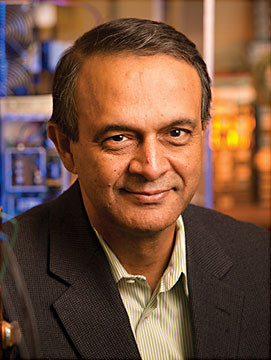Deepak Divan, Ph.D. (Emeritus)
Energy Management
Georgia Institute of Technology
Recruited: 2015
With 68 patents to his name and several more pending, Deepak Divan is an internationally recognized leader in electrical engineering research, with particular expertise in guiding technologies from concept to market. Through his research and entrepreneurial ventures, he’s made major contributions in the area of power grid monitoring, analytics and optimization.
After a hiatus spent in the Bay Area establishing his most recent start-up, Divan returned to Georgia Tech in fall 2015. As the director of the Georgia Tech Center for Distributed Energy, he leads efforts to develop the energy delivery system of the future – one that is smarter and more sustainable.
After 10 years as a professor at University of Wisconsin-Madison, Divan founded his first company, Soft Switching Technologies, in 1995. Putting his research to work, Divan and his company led essential advances in the field of soft-switching power conversion, a way of reducing the amount of energy lost when converting between different voltages on a grid. He created a device called the Dynamic Sag Corrector, which helps smooth out brief interruptions, or “sags,” in power supply that can damage devices and cause data loss.
Because more than 90 percent of power problems are caused by these sags – which last just 2 seconds or less – Divan’s invention is an efficient way of making a big impact on overall performance of the local power supply, especially in highly power-sensitive industries like healthcare, where a patient’s life can depend on reliable technology. More than 2,000 Dynamic Sag Correctors are now installed in industrial operations from car manufacturing to food preparation.
During his tenure with Soft Switching Technologies, Divan also helped develop the I-GRID, the first power monitoring network in the U.S. to be made available to the general public via the Internet. The I-GRID helps utility companies analyze power disturbances across the network to diagnose the cause.
In 2005, while a professor at Georgia Tech, Divan founded his second company, Innovolt. Through his research, Divan found that the typical surge protector available to consumers could not consistently protect electronic devices from damage. While damage is usually blamed on a voltage surge, often from lighting, Divan discovered that voltage sags are responsible for a major share of damage as well. This is because minor sags in voltage often lead to a brief spike in current. In other words, a dip in the total energy in a circuit is followed by a momentary rush of electricity flooding in to fill the gap.
Through Innovolt, Divan marketed a product to address this problem. Unlike existing surge protectors, which guard only against voltage surges, Divan’s next-generation surge protector also included protection against minor fluctuations like voltage sags and current surges, and it was available at a comparable cost.
Divan’s third start-up, Varentec, is his most ambitious enterprise to date. Funded in part by Bill Gates, Varentec is improving outdated electrical infrastructures at major industrial sites. Because rebuilding a legacy system is a massive undertaking, utility companies often hesitate to begin such a project. But Divan’s research has focused on pragmatic, efficient solutions. Understanding that rebuilding a system from the ground up isn’t always possible, he has sought more workable approaches for the real world.
Varentec’s flagship technology, Edge of Network Grid Optimization (ENGO), is one such example. ENGO is based on something called volt/VAR control, another process for managing voltage levels. Utility companies can install ENGO’s fast-response sensing and monitoring device at key points and known trouble spots in the existing grid, improving current infrastructure without a total rebuild. The device comes with built-in analytical tools and can alter voltage on the spot to adjust power loads and optimize energy use. In multiple installations at utility companies in the U.S., Mexico and Australia, Varentec’s ENGO has demonstrated 5% energy savings.
The Varentec pilot programs point the way to a more efficient grid. Not only does this kind of dynamic grid control improve energy savings overall, it also makes it easier to bring renewable energy like wind, water and solar into the mix by creating a smart grid that can analyze and recalculate on the fly to meet peaks in demand, or deal with peaks in supply.
Such a confluence is all part of Divan’s greater goal: a more flexible, resilient energy infrastructure that relies more on intelligence in the network and less on top-down control.
Research
- Soft switching power conversion
- Dynamic grid control
- Integrating distributed intelligent sensors into the network
- Improving power grid utilization
- Building more reliable power systems
- Connecting renewable energy sources to the existing grid
Straight from the Scholar
I was drawn back to Georgia Tech because the support from the Georgia Research Alliance, and the new Center for Distributed Energy offered me an opportunity to bring my academic and entrepreneurial experiences together. The problems of distributed energy we are tackling have global implications and are poised to disrupt the entire energy industry. The Center for Distributed Energy can be a major player, and help spawn new technologies with commercial impact.
Additionally, Georgia Tech has always prioritized entrepreneurial experiences for students, and I look forward to working many of these programs on campus. I am particularly excited that GRA, along with Georgia Tech, has supported the concept of an embedded Entrepreneur in Residence, a position being filled by Suresh Sharma.
Intellectual Property
68 patents

